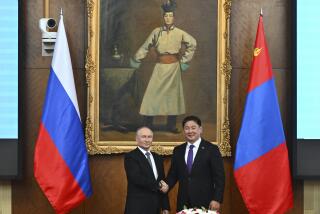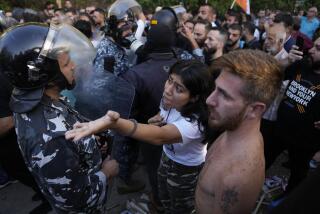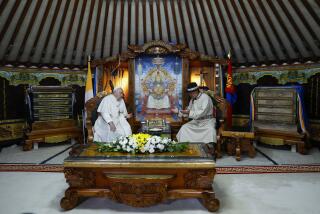Horse Race of a Different Color
- Share via
ULAN BATOR, Mongolia — You have to rise early to beat the horses.
Very early.
We’re already up and out by 5:30 a.m., walking in the predawn haze through a tent city at the base of a sweeping mountainside. The camp is stirring, and soft voices and the gentle whinny of horses float among the tents. In the distance, beyond the low smoke of cook-fires and the tethered horses, we can see a small grandstand, and, facing the grandstand from 50 feet away, a short wooden observation tower.
This is where the day will really begin when, in about an hour, about 400 horses and their young riders move from the camp to the tower, then on to a nearby ridge. Then, when all the horses have gathered, they will trot en masse 15 miles out from the city, turn around and, at the sound of a gunshot, sprint back to this little wooden tower.
That cold recitation does little to brace us for how all this actually transpires.
This is Naadam, the ancient Mongolian festival codified into a national holiday after Mongolia’s successful fight in 1921, with the help of the Russian Red Army, for independence from China. Held every July 9 to 11, the festival centers on the traditional Mongolian sports of wrestling, archery and horse riding.
But it is the spectacle of children racing horses that has brought us to this camp at the crack of dawn, for the first of three days of such races.
A Times photographer and I were in Mongolia to cover a group of Los Angeles-based physicians who traveled here to help Mongolian doctors improve medical care. The doctors’ visit coincided with Naadam, so the photographer, Gail Fisher, and I decided to take in the festivities with them.
We began with a few days in a tourist camp of gers--portable felt-and-canvas huts known to most of us by the Russian name, “yurts”--before moving on to Ulan Bator and the Naadam festival, with other side trips planned during the two-week visit. Most travelers come to Mongolia with tour groups, and ours was arranged by the Ulan Bator Foundation of Venice, which also put together the medical mission. But it’s also possible to make independent travel plans.
Given the decades of Soviet domination of Mongolia, English is not widely spoken, so hiring a driver and interpreter makes a huge difference in both freedom and comprehension. We lucked out by getting a fellow named Sodh, a hydrologist with passable English skills and a pleasing sense of humor who seemed to know everyone in the country, which proved invaluable.
*
As significant as Naadam is for Mongolians, its informality is refreshing. Tickets ($25 a day for foreigners) are required for the opening and closing ceremonies, and to watch the wrestling. Those events take place in the National Stadium, which is surrounded for the three days by vendors hawking everything from soft drinks to maps. No tickets are required for the archery competition--with both men’s and women’s divisions--which is held just outside the stadium.
The horse races take place at the city’s edge and involve both girls and boys. You can buy grandstand tickets, but you really don’t need to because the best views are from ground level. There are no crowd restraints, no ticket booths (except at the grandstand), no advertising or vendors, no souvenirs or Special Collector’s Edition Programs.
In this commercial vacuum we cross the dusty grasslands from the camp and step beneath the wooden observation tower, which will later serve as the finish line.
Then the swirl begins.
For more than an hour the horses enter the grounds, singly and in groups, circling the observation stand as the riders--children between 4 and 11 years old--chant the traditional song “Guiin Goo” for luck and inspiration before riding off to a staging area atop a nearby ridge. It is pure bedlam, a carnival of billowing dust and snorting horses and the light, excited voices of youth.
The children must be strong enough to race 15 miles, and light enough to ride quickly. Most of the riders are in saddles--a Mongolian type that keeps the rider leaning forward--but many ride bareback. All are dressed in traditional robes of deep red or vibrant yellow or mixtures somewhere in between. Few ride alone. Fathers and brothers and uncles trot alongside, slowly swelling the group at the staging area to more than 2,000 horses.
From a distance, it looks like the return of Genghis Khan’s thundering hordes.
*
Tourism exists as a nascent capitalist dream here, with rudimentary accommodations and the occasional upscale hotel in the capital, Ulan Bator, and little available elsewhere. A former Soviet satellite (Mongolia was the second nation, in 1921, to undergo a Communist revolution, opening the door to Soviet domination just after Mongolians won independence from China), Mongolia has only welcomed tourists for about the last five years, and the nation’s lack of creature comforts only adds to the mystique.
Our group’s visit was limited to the regions just outside Ulan Bator, though smaller Naadam festivals are held outside the capital in the aymags, or regional centers. Ulan Bator is the easiest way into the country, but easy is a relative term. International flights connect from Beijing, Moscow or Osaka, Japan. We flew from Beijing, although our travel agent’s representative there failed to reconfirm our airplane seats. When we showed up at the Beijing airport, we had no reservations on a flight with a standby list of 20 to 30 people in similar straits.
We managed to squeak on board the China Airplane --the next-to-last names called--but at least a dozen other travelers, mostly Western tourists, were left stranded, forced to wait for a standby seat on the next day’s flight--creating critical problems for those expecting to meet up with trekking groups.
*
For our first few nights we stayed at the Undur Dov ger camp 40 miles from Ulan Bator. Out here, the city gives way quickly to vast sweeps of emptiness, wide valleys defined by sloping brown hills covered with a light green fuzz of grass and occasional stands of larch and birch trees.
Such views suck you into the middle of them. Or to the top. Gail and I and four others from the doctors group climbed the deceivingly low hill behind the camp and were rewarded with stunning views of steppes and sloping hills stretching as far as the eye can see, dotted with gers (real ones, not tourist huts) and crisscrossed with dirt pathways traversed by horses and Russian four-wheel-drive vehicles, the country’s two main modes of transportation.
Gail and I had our own chance to try the four-legged mode when we took a day trip to a horse farm about 40 miles west of the ger camp. Some of the hardier members of our group rode horses to the edge of the craggy-peaked mountains, while the rest of us limited ourselves to short rides and hikes around the camp.
The day trip was capped by a dinner of boodog, a Mongolian dish of onions and other vegetables cooked with sheep or goat meat. Traditional boodog is cooked in a goat-skin bag filled with the vegetables, meat chunks and rocks heated in a fire. The bag is then hung over the fire until the meat is done.
For our meal, the cooking crew used something that looked like a cross between a milk can and a pressure cooker. The mutton came out tough and gristly, not exactly a gourmet dish likely to be served at one of those Mongolian Barbecue chain restaurants. While the country has shaken off the effects of a severe drought a couple years ago, food is still scarce. Fresh produce is rare and not recommended uncooked for those wishing to avoid traveler’s diarrhea. (Hepatitis also is pervasive, and travelers should be inoculated before the trip).
After two days in the countryside, we shifted our base to Ulan Bator’s twin-towered Bayangol Hotel, easing life a bit. The hotel has three restaurants, one on the main floor that was marked by slow service and uninspired food. But the two small restaurants in the towers were much better: quicker service, more reliable quality and an intimate European atmosphere.
There are other equally satisfying spots around town. The White House Hotel has a restaurant on the first floor and an English pub-style jazz club and bar upstairs. The Capital, owned by a woman from Cameroon, serves a mix of African and Continental dishes. And then there are the Star restaurants--Star One and Star Two--where the only choice of beer was, oddly enough Henry Weinhard’s, brewed in the Pacific Northwest.
We spent one day sightseeing in the capital. The national Museum of Fine Arts was limited but pleasant, with some nice examples of Mongolian paintings and sculpture going back several centuries. The Gandan Buddhist monastery and the Bogd Khan Palace, home of the last khan, were subtly intriguing, enhanced, oddly enough, by their down-at-the-heels condition. The monastery holds aging tapestries and murals depicting Buddhist tales, while the palace--which also has tapestries and smaller murals--is dominated by the Bogd Khan’s possessions--stuffed hunting trophies, furniture and the royal ger. Both complexes were built with wood, and time and lack of money have left them faded and weather-worn, giving a real sense of time and place, and of a lost past.
We capped the day with an hourlong show of traditional music and dance by the Tiumen Ekh Ensemble at its theater. The stage is an open floor facing a semi-circle of raised benches, backed by windows that are shuttered during the performance. The room quickly became stuffy and uncomfortable, but the show was so entrancing we soon forgot about the discomfort. Stringed instruments played a melodic, almost Western sound. At one point, a flute player, using circular breathing--a technique used by jazz musicians to play while inhaling--set off on a minutes-long stream of fluttering notes backed by the sharp staccato tones of a xylophone that was simply mesmerizing.
*
But it was horses, not xylophones, that formed the trip’s most memorable moments. In many cultures, traditions are sustained as relics, marketed examples of the way things once were. There’s a touch of that in the horse races of Naadam too. But in a land where half the country still leads semi-nomadic lives--following herds of sheep, goats, cattle and yaks--a cross-country race represents skills still nurtured for use, not for nostalgia.
It is a harsh race. From the start there is jostling and flailing of whips, stumbling and occasional falls. During the weekend, about 20 horses died from the heat--over 100 degrees in mid-afternoon--and scores of young riders suffered injuries, though it was not clear that any were serious.
The view from the finish line is intense. In the distance a thin cloud of dust appears on the horizon, then grows as the pack moves closer, hooves pounding the turf with a distant rumble. The pace car--a Russian vehicle--bounces over the ridge first, careening wildly, quickly followed by the horses, spread out at intervals of several yards.
As the lead horses near the finish line, the growing thunder of hooves merges with the cheers of the crowd, several thousand strong now. The winning rider, who looks to be about 8 years old, flashes across the line standing high in his stirrups, right hand triumphantly pumping above his head before he is swallowed by the crowd arrayed in a semicircle beyond the finish line.
It is a magical, and timeless, moment.
(BEGIN TEXT OF INFOBOX / INFOGRAPHIC)
GUIDEBOOK
Mongolian Odyssey
Getting there: Determined independent travelers can make their own arrangements, but it’s not easy given the distance and lack of English speakers in Mongolia. Among the tour operators specializing in the area:
The Ulan Bator Foundation (P.O. Box 3059, Venice, CA 90294; telephone [310] 821-3459, fax [310] 821-5123) ) is a nonprofit organization dedicated to establishing links between Mongolia and Southern California. Foundation founder Arnold Springer, professor of Russian history at Cal State Long Beach, leads a 19-day tour of Mongolia that includes the Naadam festival, June 26 to July 15, for $3,203 per person, air fare excluded.
Mongolian Travel USA, Inc. (707 Alexander Road, Suite 208, Princeton, NJ 08540; tel. [609] 419-4416, fax [609] 275-3827) is the American representative of Juulchin, the former state tourism board that was privatized in 1991. The firm has stakes in a number of hotels and resorts scattered across the country, and offers 11-day package tours for $1,395 per person (plus air fare), the first beginning July 18, the last beginning Aug. 29.
Genco Tour Bureau Co. (Room 204, Tower-A, Bayangol Hotel, Chinggis Khan Avenue-5, Ulan Bator-43, Mongolia; tel. 011-976-1-328-960, fax 011-976-1-326-880; Web site https://www.MOL.mn/gtb) is a new partnership involving the Bayangol Hotel in downtown Ulan Bator that offers a Naadam tour. For more information: Embassy of Mongolia, 2833 Main St. N.W., Washington, DC 20007.
More to Read
Sign up for The Wild
We’ll help you find the best places to hike, bike and run, as well as the perfect silent spots for meditation and yoga.
You may occasionally receive promotional content from the Los Angeles Times.







